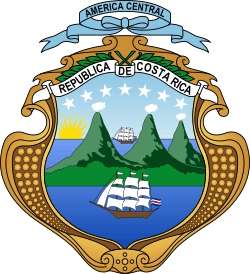1919 Costa Rican general election
General elections were held in Costa Rica on 7 December 1919.[1] Julio Acosta García of the Constitutional Party won the presidential election, whilst the party also won the parliamentary election, in which they received 74.9% of the vote.[2] Voter turnout was 57.8% in the presidential election and 42.1% in the parliamentary election.[3]
| ||||||||||||||||||||
| Turnout | 49,099 | |||||||||||||||||||
|---|---|---|---|---|---|---|---|---|---|---|---|---|---|---|---|---|---|---|---|---|
| ||||||||||||||||||||
| ||||||||||||||||||||
 |
|---|
| This article is part of a series on the politics and government of Costa Rica |
|
Legislature
|
|
|
|
|
|
|
These elections were held on December 7, 1919 after dictator Federico Tinoco was deposed and exiled. The winning candidate Acosta, former chancellor of the government overthrown by Tinoco, had been precisely one of his fierce opponents and leader of armed antitinoquist groups which earned him great popularity, this despite the fact that his affiliation as a Freemason and Theosophist were controversial, at least among some sectors of the Church.[4]
The tinoquismo grouped around the recently founded Democratic Party and nominates Dr. José Maria Soto Alfaro, denoted tinoquista, twice deputy and brother of former president Bernardo Soto Alfaro. Soto was also the founder of the so-called «Club 27 de Enero» whose name commemorated the Tinoquista coup on January 27, 1917 that overthrew González Flores and was one of the supporters of the Tinoquista regime.[5]
Results
President
| Candidate | Party | Votes | % | |
|---|---|---|---|---|
| Julio Acosta García | Constitutional Party | 42,319 | 89.1 | |
| José María Soto | José María Soto | 5,178 | 10.9 | |
| Invalid/blank votes | 7 | - | ||
| Total | 47,504 | 100 | ||
| Registered voters/turnout | 84,283 | 56% | ||
| Source: Nohlen;[4] | ||||
By province
| Province | Acosta % | Soto % | ||||||||
|---|---|---|---|---|---|---|---|---|---|---|
| 93.81 | 6.18 | |||||||||
| 83.83 | 16.16 | |||||||||
| 98.92 | 1.07 | |||||||||
| 83.85 | 16.17 | |||||||||
| 77.27 | 22.72 | |||||||||
| 85.35 | 14.64 | |||||||||
| 97.05 | 2.95 | |||||||||
| Total | 89.1 | 10.9 | ||||||||
| Source:[6] | ||||||||||
Parliament
| Party | Votes | % | Seats | |
|---|---|---|---|---|
| Constitutional Party | 26,751 | 74.9 | ||
| Democratic Party | 3,014 | 8.4 | ||
| Acostista | 2,183 | 6.1 | ||
| Constitucional | 1,911 | 5.3 | ||
| Unión provincial | 1,123 | 3.1 | ||
| Obrero acostista | 616 | 1.7 | ||
| Constitucional obrero | 106 | 0.3 | ||
| Acostista conciliador | 20 | 0.1 | ||
| Invalid/blank votes | 190 | - | - | |
| Total | 35,743 | 100 | ||
| Source: Nohlen | ||||
References
- Nohlen, D (2005) Elections in the Americas: A data handbook, Volume I, p155 ISBN 978-0-19-928357-6
- Nohlen, p164
- Nohlen, p156
- Oconitrillo García, Eduardo. Cien años de política costarricense: 1902-2002, de Ascensión Esquivel a Abel Pacheco. EUNED.
- Salazar Mora, Jorge Mario. Crisis liberal y estado reformista: análisis político-electoral (1914-1949).
- Salazar, J. (2003) Crisis Liberal y Estado Reformista, p 90 ISBN 9977-67-290-3
